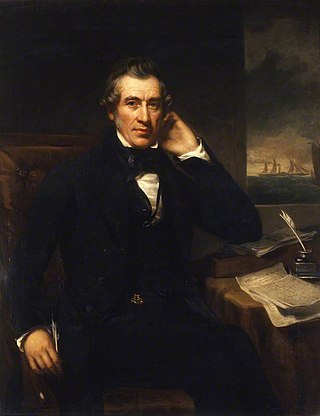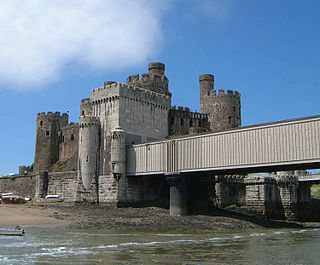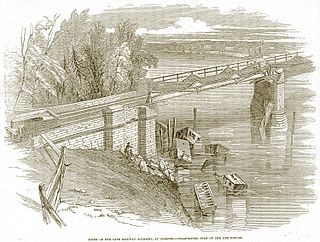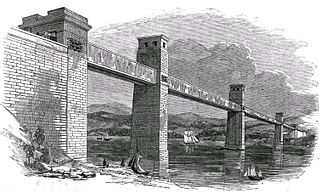
A suspension bridge is a type of bridge in which the deck is hung below suspension cables on vertical suspenders. The first modern examples of this type of bridge were built in the early 1800s. Simple suspension bridges, which lack vertical suspenders, have a long history in many mountainous parts of the world.

The Clifton Suspension Bridge is a suspension bridge spanning the Avon Gorge and the River Avon, linking Clifton in Bristol to Leigh Woods in North Somerset. Since opening in 1864, it has been a toll bridge, the income from which provides funds for its maintenance. The bridge is built to a design by William Henry Barlow and John Hawkshaw, based on an earlier design by Isambard Kingdom Brunel. It is a Grade I listed building and forms part of the B3129 road.

The Royal Albert Bridge is a railway bridge which spans the River Tamar in England between Plymouth, Devon and Saltash, Cornwall. Its unique design consists of two 455-foot (138.7 m) lenticular iron trusses 100 feet (30.5 m) above the water, with conventional plate-girder approach spans. This gives it a total length of 2,187.5 feet (666.8 m). It carries the Cornish Main Line railway in and out of Cornwall. It is adjacent to the Tamar Bridge which opened in 1961 to carry the A38 road.

Sir William Fairbairn, 1st Baronet of Ardwick was a Scottish civil engineer, structural engineer and shipbuilder. In 1854 he succeeded George Stephenson and Robert Stephenson to become the third president of the Institution of Mechanical Engineers.

Britannia Bridge is a bridge in Wales that crosses the Menai Strait between the Isle of Anglesey and city of Bangor. It was originally designed and built by the noted railway engineer Robert Stephenson as a tubular bridge of wrought iron rectangular box-section spans for carrying rail traffic. Its importance was to form a critical link of the Chester and Holyhead Railway's route, enabling trains to directly travel between London and the port of Holyhead, thus facilitating a sea link to Dublin, Ireland.

The Conwy Railway Bridge carries the North Wales coast railway line across the River Conwy between Llandudno Junction and the town of Conwy. The wrought iron tubular bridge, which is now Grade I listed, was built in the 19th century. It is the last surviving example of this type of design by Stephenson after the original Britannia Bridge across the Menai Strait was partially destroyed in a fire in 1970 and rebuilt as a two-tier truss arch bridge design.

A tubular bridge is a bridge built as a rigid box girder section within which the traffic is carried. Famous examples include the original Britannia Bridge over the Menai Strait, the Conwy railway bridge over the River Conwy, designed and tested by William Fairbairn and built by Robert Stephenson between 1846 and 1850, and the original Victoria Bridge in Montreal.

The Dee Bridge disaster was a rail accident that occurred on 24 May 1847 in Chester, England, that resulted in five fatalities. It revealed the weakness of cast iron beam bridges reinforced by wrought iron tie bars, and brought criticism of its designer, Robert Stephenson, the son of George Stephenson.

A box girder or tubular girder is a girder that forms an enclosed tube with multiple walls, as opposed to an I- or H-beam. Originally constructed of wrought iron joined by riveting, they are now made of rolled or welded steel, aluminium extrusions or prestressed concrete.

The Landore viaduct is a railway viaduct over the Swansea valley and the River Tawe at Landore in south Wales. It provides a link between Swansea city center and the West Wales Line to the South Wales Main Line. The valley crossing provides a panoramic view of Landore, Kilvey Hill, the Liberty Stadium and the Swansea Enterprise Park.

The Loughor railway viaduct carries the West Wales Line across the River Loughor. It is adjacent, and runs parallel to, the Loughor road bridge. The 1880 viaduct was granted Grade II listed building status. Before it was demolished in early 2013, the viaduct was the last remaining timber viaduct designed by Isambard Kingdom Brunel.

The Saltwater River Rail Bridge is a large steel arch truss railway bridge completed in 1858 and crossing the Maribyrnong River on the Melbourne to Footscray railway in Melbourne, Victoria. It had the longest span of any bridge in Victoria for thirty years.

The Usk Railway Bridge is a railway viaduct in Newport city centre, Wales. It crosses the River Usk in an east—west direction, carrying the Great Western Main Line.

The Victoria Bridge, also known as the Victoria Bridge over the Nepean River, is a heritage-listed former railway bridge and now wrought iron box plate girder road bridge across the Nepean River on the Great Western Highway in the western Sydney suburb of Penrith in the City of Penrith local government area of New South Wales, Australia. The bridge was designed by John Whitton, the Engineer–in–Chief of New South Wales Government Railways, and built from 1862 to 1867 by William Piper, Peto Brassey and Betts (superstructure), William Watkins (piers). It is also known as Victoria Bridge, The Nepean Bridge and RTA Bridge No. 333. It was added to the New South Wales State Heritage Register on 27 May 2016.

The Monmouth Viaduct or Chippenham Meadow Viaduct is a 20-arch 183m red sandstone viaduct, with two 23m steel lattice-girder spans over the river. It carried the Coleford, Monmouth, Usk & Pontypool Railway line across the River Wye at Monmouth, Wales. A further river crossing by the Ross and Monmouth Railway was later built nearby.

Gaunless Bridge was a railway bridge on the Stockton and Darlington Railway. It was completed in 1823 and is one of the first railway bridges to be constructed of iron and the first to use an iron truss. It is also of an unusual lenticular truss design.

A balloon flange girder or (colloquially) balloon topper is a form of vertical I-beam wrought iron plate girder, where the top flange, instead of being a simple flat plate, is extended into a hollow tube. When a girder is subjected to a positive bending moment the top flange acts in compression making a flat plate flange more susceptible to local buckling than the balloon flange is.

Broadbottom Viaduct is a railway viaduct that spans the River Etherow between Derbyshire and Greater Manchester in England. Originally of wooden construction supported by stone piers, the timber was replaced first with wrought iron box girders, less than 20 years after the viaduct's opening, later followed by steel trusses and more supporting piers.

The Surtees Rail Bridge is a rail bridge on the Tees Valley Line over the River Tees in the Borough of Stockton-on-Tees. The bridge is south of Stockton-on-Tees town centre and just north of the adjacent Surtees Bridge which carries the A66 road. The bridge is built on the site of a series of Tees Bridges alternating between two adjacent crossing sites.























